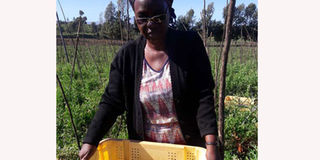New app makes farmers accountable to consumers

Janet Mugambi shows part of her garden peas harvest. PHOTO | RACHEL KIBUI | NATION MEDIA GROUP
What you need to know:
- The software tracks farmers’ crops right from planting to the time they are sold to the consumer, enabling the end user to know how the food he is consuming was produced.
- The information is transmitted to Veg Pro, the exporting company, regulatory bodies such as Kenya Plant Health Inspectorate Services and Horticultural Crops Directorate.
- Through the system, consumers are able to see the produce and farmer’s details and the exact location of the farm
The sunny weather in Timau allowed us to see the peak of Mt Kenya as we drove on.
The mountain was scenic, making one appreciate the beauty of one of Kenya’s most important landmarks.
We drove few kilometres from Timau shopping centre, and turned left on a rough road to reach Teleswani Farm, where French beans and Garden peas are thriving for export.
We met Janet Mugambi, the owner of the farm. She had joined workers in harvesting the crops.
And as she harvested, James Gichuru, who works for Veg Pro Kenya Ltd, the buyers of Janet’s produce, documented her personal details, the quantity and quality of the harvest, among others, in a smart phone application.
Janet is among farmers using the app that is changing how the horticulture exports are produced, making the farmer accountable to the consumer and reducing cases of rejected produce.
The software tracks farmers’ crops right from planting to the time they are sold to the consumer, enabling the end user to know how the food he is consuming was produced.
“The system captures the age of the farmer, her ID number, trace code number, block number and the type of crops. The information is sent to a centralised computerised data system in Nairobi,” said Gichuru, noting they work with 60 farmers in Timau, Meru County.
Gichuru visits each farmer weekly and records activities like planting, which seeds were planted, how much, and if the seeds were treated before planting.
He then follows up on issues like fertiliser and chemical application, weeding and harvesting.
The information is transmitted to Veg Pro, the exporting company, regulatory bodies such as Kenya Plant Health Inspectorate Services and Horticultural Crops Directorate.
SHARING INFORMATION
Dubbed the National Horticultural Traceability System (NHTS), the application further allows sharing information with the export outlets under the European Union market.

The mobile application that farmers use in Timau. PHOTO | RACHEL KIBUI | NATION MEDIA GROUP
“Through the system, consumers are able to see the produce and farmer’s details and the exact location of the farm,” explained Gichuru, adding they can also tell what chemicals were used on the produce and trace the farmer in case of a problem.
Janet said she faced challenges resulting from residue levels, making her produce rejected before she went for the technology in a pilot project. More challenges arose from mix up of produce from different farmers, making traceability difficult.
“With this system, which is fool-proof, there are no chances of produce or record confusion as information is saved digitally,” said Janet, who during our visit harvested 350kg of French beans. She no longer keeps records on paper.
A farmer earns between Sh40 and Sh80 for each kilogram.
Abel Mosigisi, an agronomist working with the farmers, said the system has three components namely a mobile app for registering farmers and capturing routine farm operations and agronomic practices; a web reporting portal for sharing information among stakeholders and a barcode and Quick Reference (QR) code printing module.
The NHTS, a brainchild of HCD, is customised for Kenya’s smallholder export industry and can accommodate up to a million farmers.
Currently, the system which was launched Thursday, covers about 1,500 farmers working with 12 exporting companies in Meru, Baringo and Taita, among other areas.
Agriculture Cabinet Secretary challenged HCD and other players to apply the same technology for local market.
“The export market can be a benchmark but let’s apply the same safety measures locally,” said Willy Bett, the Agriculture CS.
He regretted that some produce from rejected by the export market, somehow finds way into the local market.





